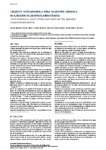Mostrar el registro sencillo del ítem
Listado de medicamentos a evitar en atención primaria y su aplicación en pacientes polimedicados
| dc.contributor.author | Montáns-García, Raquel | |
| dc.contributor.author | Gómez-Besteiro, María I. | |
| dc.contributor.author | Campos-Toimil, Manuel | |
| dc.contributor.author | Balboa-Barreiro, Vanesa | |
| dc.date.accessioned | 2022-05-25T08:43:55Z | |
| dc.date.available | 2022-05-25T08:43:55Z | |
| dc.date.issued | 2022 | |
| dc.identifier.citation | Montáns-García R, Gómez-Besteiro MI, Campos-Toimil M, Balboa-Barreiro V. Listado de medicamentos a evitar en atención primaria y su aplicación en pacientes polimedicados. Galicia Clin. 2022;83(1):6-11 | es_ES |
| dc.identifier.issn | 0304-4866 | |
| dc.identifier.uri | http://hdl.handle.net/2183/30740 | |
| dc.description.abstract | [Resumen] Introduction: La alta prevalencia del uso de medicación inadecuada y sus importantes consecuencias para la salud requieren herramientas específicas y ágiles que ayuden a detectarla y evitarla. Objetivo de este trabajo fue elaborar un listado de medicamentos a evitar en AP y aplicarlo en pacientes polimedicados de un servicio asistencial de Atención Primaria (AP). Métodos: En la Base de datos del Consejo General de Colegios Oficiales de Farmacéuticos español (BOT-Plus) se comprobó el estado y disponibilidad de cada uno de los 93 medicamentos del Listado Prescrire 2019. Se elaboró el Listado de medicamentos a evitar en AP con aquellos que estaban comercializados en España y se excluyeron los que no estaban financiados y los de uso exclusivo hospitalario. 2 2 Con el listado de medicamentos a evitar en AP se hizo un análisis retrospectivo de todos (N=262) los informes de prescripción de polimedicados >10 medicamentos del año 2017 en un servicio asistencial de AP (5 centros de salud). Se realizó análisis de frecuencias, medidas de tendencia central y dispersión; se estimaron (IC 95%) y se utilizó X o exacta de Fisher para determinar la asociación entre variables y análisis de regresión logística. Resultados: Se observó una prevalencia de polimedicados de 1,2%, con una media de edad de 71,7 ± 12,4 años y una media de prescripciones de 12 ±1,7 medicamentos. El listado de medicamentos a evitar en AP incluyó 45 principios activos. Los fármacos a evitar más usados han sido: duloxetina, sitagliptina y olmesartán. El 50,4% de los polimedicados tenían al menos un medicamento a evitar y una edad media de 68,5±11,8 años. El sexo fue un factor de riesgo de prescripción inadecuada, el hecho de ser mujer incrementa con un OR=1,8 (IC 95%=1,3-3,0) la probabilidad de medicamentos a evitar. Conclusiones: Un alto porcentaje de pacientes polimedicados tienen prescripto al menos un medicamento a evitar. El listado de medicamentos a evitar en AP es una herramienta útil para identificar la medicación inadecuada y para uso de los profesionales de AP. | es_ES |
| dc.description.abstract | [Abstract] Introduction: The high prevalence of inappropriate medication use and its important health consequences for health require specific and agile tools to detect and avoid it. The objective of this work was to elaborate a list of medications to avoid in Primary Care and to apply it on the polymedicated patients of a Primary Care assistance service. Methods: In the Database of the Spanish General Council of Official Associations of Pharmacists (BOT-Plus) the status and availability of each of the 93 MAE of the Prescrire 2019 List was checked. The list of medications to be avoided in Primary Care was drawn up with those that were marketed in Spain and excluded those that were not financed and those for exclusive hospital use. With the list of medicines to avoid in Primary Care, a retrospective analysis was made of all the prescription reports of polimedicated >10 medications for 2017 in a Primary Care services (N=262) in 5 health centers. Frequency analysis, central tendency measures and dispersion were carried out; they were estimated [CI: 95%] and X or Fisher’s exact was used to determine the association between variables and logistic regression analysis. Results: A prevalence of polymedicated drugs of 1.2% was observed, with a mean age of 71.7 years (DT± 12.4) and a mean prescription of 12 drugs (DT±1.7). The list of medications to be avoided in PC included 45 active ingredients. The 50.4% of the polymedicated had at least one drug to avoid and an average age of 68.5 years (DT±11.8). Sex was a risk factor for inappropriate prescription, the fact of being a woman increases with an OR=1.8 (IC95%=1, 3-3.0) the probability of having some medicines to avoid. The most commonly used drugs to avoid were: duloxetine, sitagliptin and olmesartan. Conclusions: A high percentage of polymedicated patients are prescribed at least one drug to avoid. The Primary Care medication avoidance list is a useful tool for identifying inappropriate medication and for the use by Primary Care professionals. | es_ES |
| dc.language.iso | spa | es_ES |
| dc.publisher | Sociedad Gallega de Medicina Interna | es_ES |
| dc.relation.uri | https://doi.org/10.22546/64/2499 | es_ES |
| dc.rights | Atribución-NoComercial-SinDerivadas 3.0 | es_ES |
| dc.rights.uri | http://creativecommons.org/licenses/by-nc-nd/3.0/ | * |
| dc.subject | Polifarmacia | es_ES |
| dc.subject | Atención primaria de salud | es_ES |
| dc.subject | Revisión de la utilización de medicamentos | es_ES |
| dc.subject | Polypharmacy | es_ES |
| dc.subject | Primary health care | es_ES |
| dc.subject | Drug utilization review | es_ES |
| dc.title | Listado de medicamentos a evitar en atención primaria y su aplicación en pacientes polimedicados | es_ES |
| dc.title.alternative | List of Medicines to Avoid in Primary Care Health and Their Application In Polymedicated Patients | es_ES |
| dc.type | info:eu-repo/semantics/article | es_ES |
| dc.rights.access | info:eu-repo/semantics/openAccess | es_ES |
| UDC.journalTitle | Galicia Clínica | es_ES |
| UDC.volume | 83 | es_ES |
| UDC.issue | 1 | es_ES |
| UDC.startPage | 6 | es_ES |
| UDC.endPage | 11 | es_ES |
Ficheros en el ítem
Este ítem aparece en la(s) siguiente(s) colección(ones)
-
GI-GIRS - Artigos [86]






